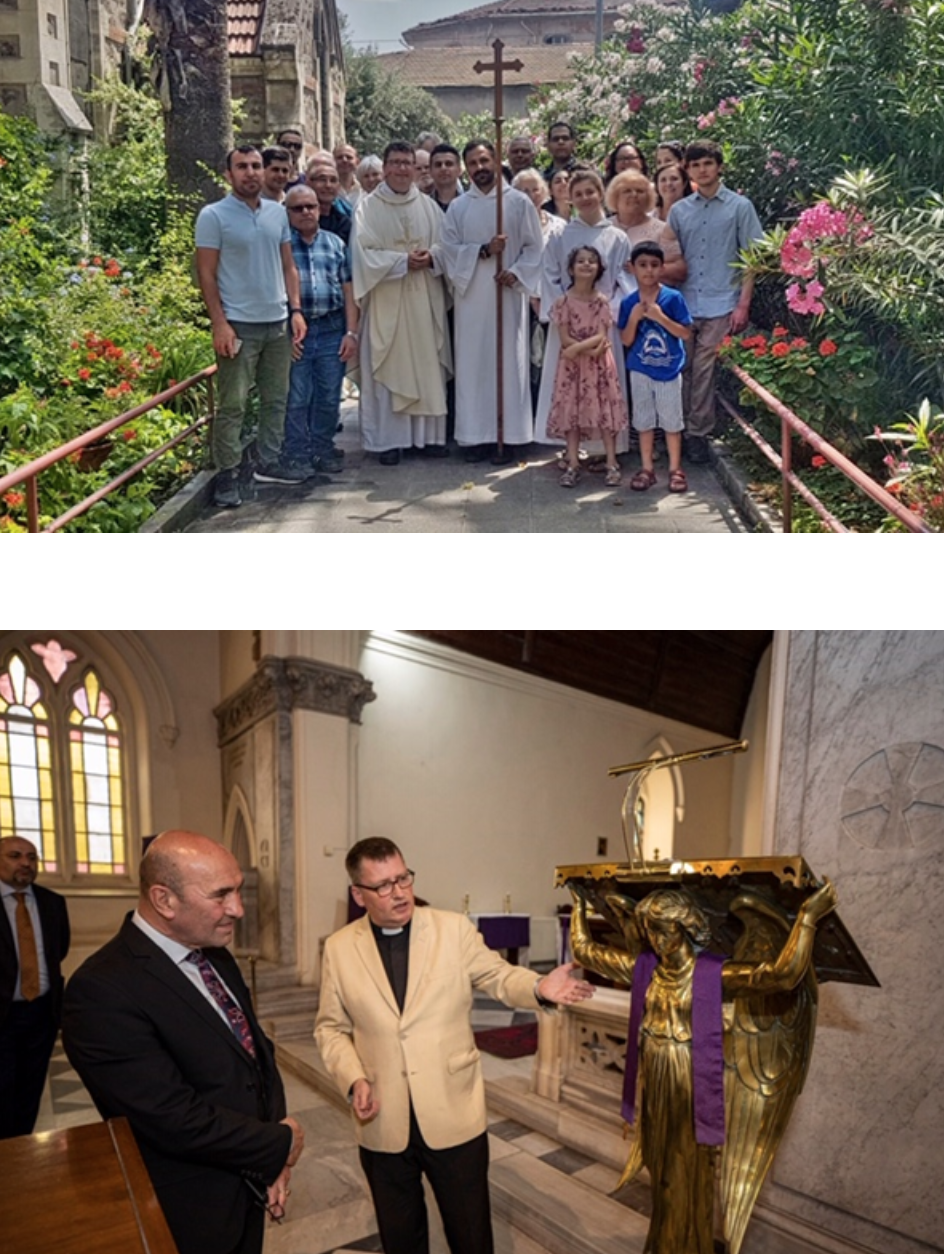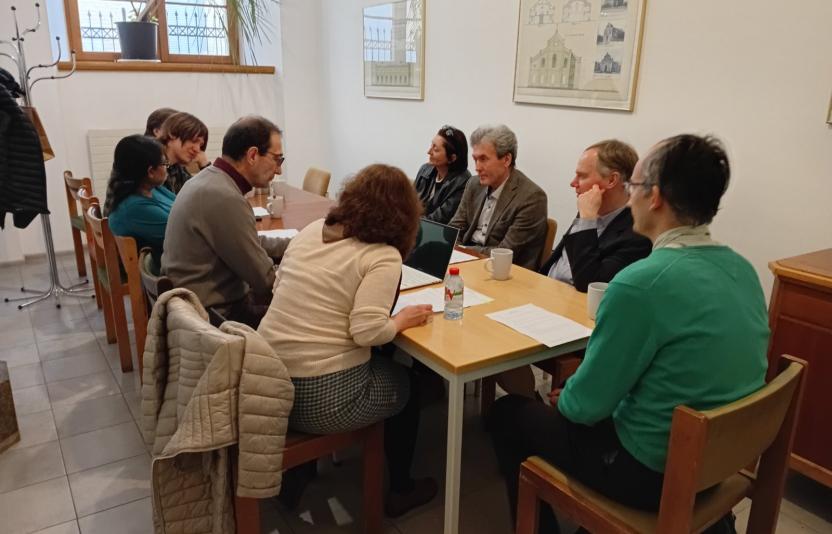Letter from Izmir
The Revd James Buxton writes:
The Book of Revelation tells us that there was a very early Christian community in Smyrna. It is one of the seven churches of Asia, indeed it was then and remains now a large and wealthy provincial capital. At over four million souls it is the biblical city with by far the largest present-day population. It’s easy to see why the city has thrived over at least 30 centuries. Izmir is situated at the head of the Gulf of Smyrna, a wonderful natural harbour. The city is dominated by Mount Pagus, a magnificent vantage point and site of Izmir’s citadel, the Kadifekale (‘velvet castle’). Crucially it is well watered and surrounded by marvellous agricultural land. These factors have made it a lively port city and centre of regional power since the days of yore.
It was the trading opportunities that brought the specifically Anglican element to the city’s story, when the Levant Company sent out its first chaplain (Thomas Curtys) in 1636, to see to the pastoral care of the company’s employees. These were mainly single young men, subject to the many temptations provided by any large port city. Not an easy job for the chaplain, I suspect. By the middle of the nineteenth century a wealthy and settled expatriate community had evolved, with families from France, Spain, Italy the Netherlands, Germany and Britain living in the city and making the most of opportunities for trade and industry, each community supported by its own churches. By this time, the chaplain’s role had become much more like that of an English parish priest. Our current church (consecrated in 1900) was constructed by railway workers who lived and worked in the northern part of the city near the port, and were mainly engaged in building a new railway line through the agriculturally rich areas extending south to the city of Aydin.
The last few decades have seen the need, once again, for a different style of ministry. Hardly anybody expects us to provide a sense of ‘Little England’ these days. We are now an international English-speaking congregation with members from many different parts of the word, including English teachers, refugees and migrants, as well as Christian locals who wish to worship in English. We are a mix of Anglicans and members of other Christian denominations. By contrast with former days, none of us is involved in trade or the railways, though our churchwarden Alan Prior is an extreme railway enthusiast!
The city has experienced long periods of peace and prosperity interspersed by violent traumas. Earthquakes, plagues, wars, fires, and the dreadful events a few years after the end of the First World War, when the city burnt to the ground and many tens of thousands of its Christian residents expired in the fire, or in the sea, or had to flee for their lives. St John’s Church was just at the edge of the fire zone, and the fact that it survived makes it a sign of continuity in a city that is mostly characterised by modern buildings. These days Christians number just a few thousand. I guess as Anglicans, we are the smallest recognized minority, with about 50 souls. Given the small scale of our community, we are very grateful for the friendly relationship we have with the city authorities. The Mayor of Greater Izmir has recently been to visit us and assured us of his help in fixing our roof. Late last year I had an audience with the Governor of the city who promised his personal help should we face any difficulties. As the leader of the city’s smallest religious minority, I find these acts of kindness and support very encouraging.

Against the background of the disasters of former years and the current good relationships, the last few months, dominated by the Coronavirus pandemic, have not been too harsh. The Turkish response to the crisis has been very similar to the responses we have seen in the UK and other European countries. Mosques synagogues and churches closed for public worship at around the same time as those in the UK. As a congregation we have been staying together on Zoom as many communities around the world have done. I was surprised and pleased to find that almost all our regular congregation were able to gather in this way.
I have also prepared a weekly podcast for members of the congregation at St Mary’s, Didim (two hundred miles south of Izmir), and some others who are not able to use Zoom. Our weekly pattern of Bible Study and evening prayer has been retained. As the regular Bible Study leader, I have appreciated the greater sense of focus we have found when we open the pages of the Bible together on Zoom. We are also holding an Alpha course on-line, which is proving incredibly helpful in preparing new Christians in our community who are preparing for Baptism and Confirmation.

Whilst we shall want to retain some element of our on-line gatherings in the future, we are all looking forward to seeing each other again in church in the relatively near future. The Roman Catholic churches, and the Orthodox church in Izmir have returned to their churches in the last two or three weeks. We however plan to ‘return’ on Sunday 5 July by which time we hope that all restrictions on the under 20s and the over 65s will have been lifted.
Although ministry to our community has been able to carry on through the Pandemic, the same cannot be said of my role as Mission to Seafarers Chaplain to Izmir port. The entrance to the port is just a few hundred yards from St John’s church, but since the beginning of March, visiting has sadly been out of the question. Shipping of course has continued through the pandemic, but at a greatly reduced rate. It has been a fearful time for Seafarers, who may be isolated and worried about their families ‘back home’ at the best of times, but are now experiencing a heightened level of anxiety. I look forward very much to being able to offer pastoral care to seafarers, as restrictions are lifted in the coming months.
Just over a year ago we restored and re-set a stained-glass image of St Polycarp. The window is in the entrance porch, so that all our visitors catch a glimpse of our martyr-saint as they come and go from St John’s Church. Beneath the figure of the saint are written words from the letter to the church at Smyrna in Revelation: ‘Be faithful unto death and I will give you the crown of life’. (Revelation 2:10). Bishop Robert dedicated this new window when he visited us in February last year. Polycarp reminds us to remain faithful no matter what. I give thanks for God’s faithfulness to this city through thick and thin over many centuries past, and I pray that our particularly Anglican response to that faithfulness may continue to be made here for many years to come.

The Revd James Buxton is Chaplain of the Church of St John the Evangelist Izmir, Diocese in Europe, and Mission to Seafarers Chaplain. St John’s Church is an Intercontinental Church Society Mission Partner.
***
You can also view a video about St John's, Izmir, recorded by the Chaplain.
***
Photos: The Revd James Buxton
Top to bottom:
- The congregation at the church of St John the Evangelist Church Izmir, June 2019
- Introducing the Mayor of Izmir, Mr Tunc Soyer, to the angel lectern at the Church of St John the Evangelist, Izmir, March 2020.
- Sunday service on Zoom, April 2020, chaplaincy flat, Izmir
- The restored stained-glass window before fitting in the entrance porch of St John’s Church. The window is being held by the artist/craftsman Mr Ali Belli of Izmir. January 2019.


